Monastic-Lay Relations in Huizhou and the Transformation of Traditional Society from the “Mentu” Documents
Abstract: Although the extant “mentu”(门图)documents are rather limited, they serve as invaluable historical sources for observing regional social transformations. In Huizhou during the traditional era, Buddhist monks and Taoist priests constituted a particularly distinctive group. Since the Song Dynasty, influential local clans became crucial supporters of temple and monastery development. At the time, it was common for powerful lineages to establish and maintain temples (or Daoist shrines), resulting in a significant degree of dependency between these religious institutions and specific kinship groups. However, by the mid-Ming Dynasty onward, significant shifts emerged in the relationships between many kinship groups and Buddhist/Taoist temples. During this period, numerous disputes arose surrounding these religious institutions, centering on a key question: Were certain temples and monasteries-which by then had developed ambiguous ties with their original patron lineages-established primarily to serve ancestral worship for specific clans, or had they always been communal religious sites open to multiple lineages from the outset牽 Examining historical realities, we find that during the early and mid-Ming periods, many lineages had gradually neglected their traditional support and control over Buddhist and Daoist temples. Consequently, these religious institutions made concerted efforts to emancipate themselves from the dominance of particular kinship groups. It was likely in this context that monastic communities progressively developed their distinctive “mentu” system, thereby transforming formerly lineage-specific temples into communal religious centers serving multiple surname groups. Precisely within this context, the “mentu” system evolved into a form of monastic property rights that could be inherited, bought, sold, or mortgaged. By developing these “mentu” networks, Buddhist and Daoist clergy significantly enhanced their economic autonomy, thereby breaking free from their traditional dependence on specific patron lineages. This growing independence inevitably sparked renewed conflicts between monastic institutions and their former benefactors. In Huizhou during this period, the very disputes between lineages and monastic communities (as well as with tenant servants or minor surname groups) paradoxically strengthened lineage consolidation. These developments represented fundamental transformations in both religious and secular spheres amid Huizhou's dramatic social restructuring from the mid-Ming onward.



 沪公网安备 31010102003103号
沪公网安备 31010102003103号 DownLoad:
DownLoad: